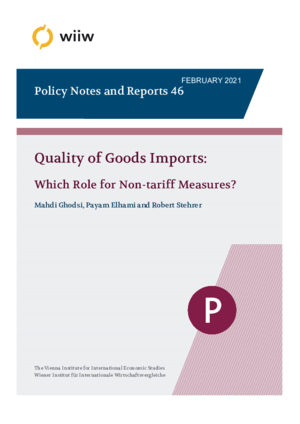Quality of Goods Imports: Which Role for Non-tariff Measures?
Payam Elhami, Mahdi Ghodsi and Robert Stehrer
wiiw Policy Note/Policy Report No. 46, February 2021
23 pages including 6 Figures
Eight multilateral rounds of negotiations under the General Agreement on Tariffs and Trade (GATT) and international agreements under the World Trade Organisation (WTO) have contributed significantly to the reduction of tariffs among WTO members. However, the imposition and use of non-tariff measures (NTMs) have surged over the years, mostly for legitimate policy goals. Among these measures, technical barriers to trade (TBTs) and sanitary and phytosanitary (SPS) measures, in particular, allow countries to impose restrictions on the imports of low-quality products suspected of harming domestic consumers’ health, plants, animals or the global environment. Such trade policy instruments aim to force higher standards in the import market and to ensure alignment with domestic regulations. The main question therefore is whether and how regulative NTMs affect trade flows, and in particular the quality of traded goods. Following the theoretical framework proposed by Feenstra and Romalis (2014), we theoretically illustrate how NTMs affect the average quality of imported products, while also incorporating the impact on the quantity and value of imports. The framework then allows us to estimate the impact of NTMs on traded values, quantities, unit values, quality and quality-adjusted prices at the detailed HS six-digit level. The results of the various estimated variables for all countries at the detailed product level are available in a visualised format (Tableau) as well as an online data appendix, providing comprehensive insights for scholars and policy makers. Generally, the results point towards a quality-increasing impact of regulative NTMs, though this may come with lower traded quantities or values. These aspects must be weighed against the positive outcomes, i.e. the compliance with the aims of the regulations concerning health, security or environmental goals and the overall increase in quality. Imposing such measures should therefore be done in such a way that they reduce trade frictions as much as possible while recognising the legitimate motivations behind the imposition of NTMs. Further, harmonisation of standards at the multilateral level may circumvent potential frictions while supporting the overall aims of regulative NTMs.
Keywords: non-tariff measures, technical barriers to trade, sanitary and phytosanitary measures, quality of products, global bilateral trade
JEL classification: F13, F14, L15
Countries covered: non specific, The World
Research Areas: International Trade, Competitiveness and FDI, Sectoral studies
